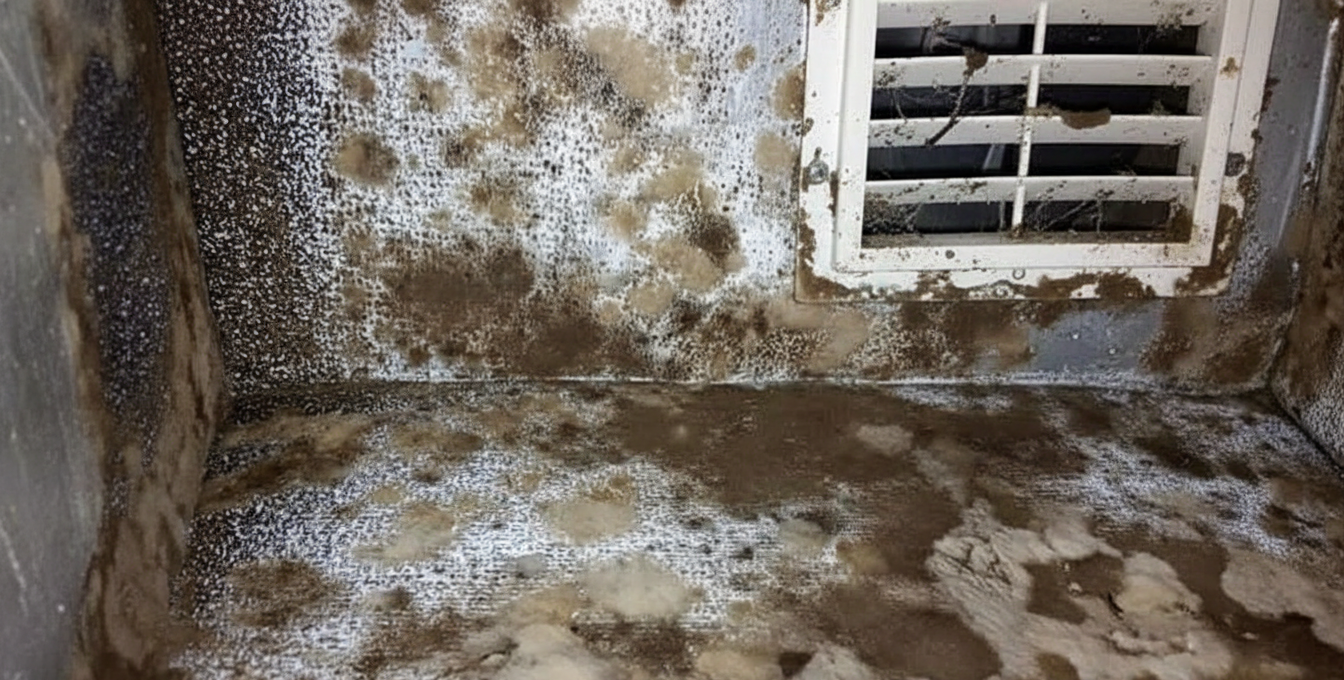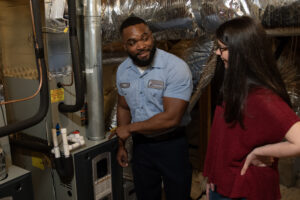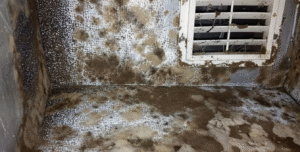
If you notice a musty smell when your HVAC runs, dark dust or black streaks around registers, or household allergy symptoms that flare while you’re at home, you may have mold in your air ducts. Mold in ductwork is fixable, but the fix that lasts removes contamination and corrects the moisture problem that caused it. If you want professional help, schedule a consultation now to review your options.

Why mold in air ducts matters (short, practical answer)
Mold is a living organism that disperses microscopic spores into the air. When mold grows inside your HVAC (Heating, Ventilation, and Air Conditioning) system or air ducts, those spores can be circulated throughout your home every time the system runs — producing musty odors, aggravating allergies or asthma, and sometimes reducing system efficiency. For federal-level guidance on mold health and cleanup basics, see the CDC (Centers for Disease Control and Prevention). For specific guidance on duct cleaning and when it’s appropriate, see the EPA (Environmental Protection Agency).
What mold in air ducts can look, feel, and smell like
Mold comes in many colors and textures. In duct systems, it commonly appears as black, green, gray, or brown spots, but it can also be powdery, fuzzy, or slimy depending on species and moisture conditions. The first clues are often sensory — what you smell and how people in the house feel.
Common early indicators:
- A persistent, musty, or earthy smell that’s stronger when the heating or cooling runs.
- Dark streaks or black dust near registers, return grilles, or the air handler.
- Allergy-like symptoms for occupants that improve when they leave the home.
If you want a deeper explanation of mold types and health connections, NIOSH (the National Institute for Occupational Safety and Health) and the CDC have useful resources on testing and health effects: see NIOSH mold guidance and the CDC mold page.

8 clear signs you may have mold in your air ducts
- Musty smell when the system runs. A damp, “basement” or “wet leaves” odor that appears or intensifies when the HVAC runs is the most common early sign. If it goes away when the system is off and returns with airflow, the source is likely in the system.
- Visible dark spots or fuzzy growth near registers or grilles. Spots or streaks that don’t wipe away easily are suspect.
- Black dust or particulates blowing from vents. Dry mold fragments or spores can look like soot or fine black dust.
- Allergy-like symptoms mainly at home. Sneezing, itchy eyes, congestion, or worsened asthma when indoors (but not elsewhere) can indicate airborne contamination from ducts.
- Moisture, condensation, or water stains around ducts or the air handler. Mold needs water—condensate pan overflow, leaking coils, or roof/plumbing leaks are common culprits.
- Mold on filters, grilles, or return vents. If filters or returns show growth, contamination likely extends deeper.
- Mold that returns after surface cleaning. If mold disappears and quickly reappears, the colony is probably inside ducts or the air handler.
- Fuzzy, splotchy, or speckled textures inside accessible ducts. Flashlight checks revealing cottony or clustered patches point to established colonies.
For a concise government view on when you should consider duct cleaning and concerns over porous materials, reference the EPA’s “Should You Have the Air Ducts in Your Home Cleaned?” guidance.

What causes mold inside ductwork — the simple science
Mold requires three essential elements: moisture, food, and time.
- Moisture sources include leaking condensate pans, clogged drains, leaking coils, roof or plumbing leaks, or humid return air from an attic or crawlspace.
- Food is dust, pet dander, skin cells, and organic debris that naturally accumulate inside ductwork.
- Time and low airflow pockets let colonies establish.
ASHRAE (the professional society for HVAC engineers) and public health sources emphasize moisture control as the most effective prevention measure. For technical positions on indoor dampness, see ASHRAE’s guidance on indoor mold and moisture control.
Should you test your ducts for mold?
Testing isn’t always necessary. The EPA says if you can see or smell mold, testing usually won’t change your response — you already have proof you need cleanup and moisture control. Testing is useful when you need documentation for insurance, litigation, or a clinician requests species-specific info for a medically vulnerable person. If you do test, use a reputable lab (e.g., JSE Labs) and understand sampling limitations. Refer to JSE Labs’ mold testing resources for a lab-style context.
Immediate homeowner steps (safe, practical, and effective)
These short-term actions reduce exposure and prepare you for professional remediation:
- Document evidence. Photograph visible mold, stains, and moisture. Time-stamped photos help with insurance and contractor communication.
- Change the filter. Install a fresh, properly sized filter to reduce airborne spores — but remember a filter won’t remove mold already growing inside ducts.
- Lower humidity. Use exhaust fans, run dehumidifiers, and aim for indoor relative humidity under ~50%. The CDC and NIOSH advise drying wet materials quickly to prevent mold growth.
- Clean accessible components. Remove the register covers and clean them with detergent and water (wear gloves and a mask). Dry thoroughly before reinstalling.
- Limit HVAC runtime if contamination seems heavy. If you suspect extensive mold inside the system, running the HVAC may spread spores — consider reducing runtime until a pro inspects.
Don’t blast ducts with compressed air, use foggers of unapproved chemicals, or spray bleach deep into the system — these tactics often do more harm than good. The EPA explains that improper cleaning methods can spread spores or damage equipment. See the EPA page on duct cleaning.

When to call a professional — and what a good process looks like
Call a trained indoor air quality or HVAC remediation professional when:
- You find substantial visible mold inside hard-surface ducts or the air handler.
- Musty odors persist despite basic cleaning and humidity control.
- Occupants develop ongoing symptoms tied to the home environment.
- You’ve had recent water damage affecting HVAC components.
A reputable contractor should follow recognized standards (look for NADCA membership and adherence to NADCA’s ACR standard). NADCA’s guidance explains acceptable cleaning methods and when components must be replaced. See NADCA (National Air Duct Cleaners Association).
A proper professional remediation typically includes:
- Assessment and scoping — camera inspection of ducts, coil, and drain pan checks.
- Moisture repair — fix the leaks or condensate issues that allowed mold to start. Fixing moisture is the single most important step.
- Containment — negative air and containment to avoid spreading spores into the living space during work.
- Cleaning & removal — HEPA vacuuming, mechanical agitation for hard surfaces, and replacement of porous materials (insulated liners or wet fiberglass) that cannot be effectively cleaned. The EPA cautions that porous materials often require replacement.
- Verification — photos, condition reports, and optional surface sampling to confirm remediation.
For contractor-level examples and what remediation firms recommend, see resources from PuroClean and COIT. These sites describe step-by-step processes similar to NADCA and EPA guidance.
DIY vs. professional — what’s worth trying yourself
- DIY: safe for small, superficial mold on removable covers or for reducing humidity and documenting the issue. Follow CDC cleaning, PPE, and guidance.
- Professional: required for mold in ducts, inside the air handler, or widespread contamination — pros have containment, HEPA equipment, and training.
- Replacement: Insulated/fiberglass-lined ducts or damaged flexible ducts that were wet often need replacement because cleaning does not reliably remove mold from porous materials (EPA and NADCA notes).
For testing labs and deeper sampling, JSE Labs and similar accredited labs provide analysis when documentation is necessary.
How to prevent mold in your ducts: an owner’s checklist
- Control humidity: Keep indoor relative humidity under ~50% with dehumidifiers and ventilation.
- Routine HVAC maintenance: Annual or biannual tune-ups to inspect coils, drains, and insulation.
- Replace filters correctly: Change filters every 1–3 months based on household conditions (pets, allergies).
- Consider IAQ upgrades: UV-C lights at the coil, whole-home purification systems, and higher-efficiency filtration can reduce microbial loads on system components — read more on our Air Purification resources.
FAQs
Can mold in air ducts make my family sick?
Mold exposure can trigger or worsen allergies and asthma in sensitive people. Public health sources recommend addressing visible mold and moisture promptly; see the CDC’s mold resources.
Will duct cleaning fix mold permanently?
Cleaning removes mold from hard, non-porous surfaces, but porous contaminated materials often require replacement. Without fixing the moisture source, mold usually returns. See the EPA’s guidance on duct cleaning.
Should I test my ducts for mold?
Testing is rarely necessary when you can see or smell mold. It’s useful for documentation or clinician requests. If you test, use an accredited lab and understand sample limitations — see JSE Labs.

What you can do right now
- Photograph visible issues and note when odors or symptoms occur.
- Change your HVAC filter and reduce humidity.
- If multiple signs are present — especially visible mold in ducts or near the air handler — Schedule a consultation now to review your options.






